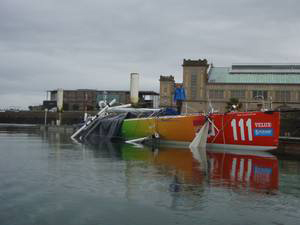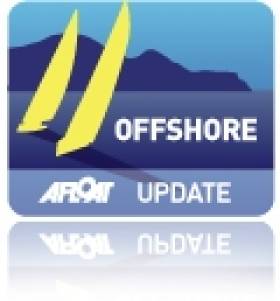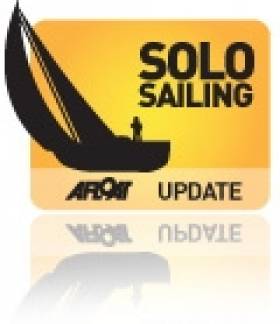Displaying items by tag: Five Oceans
Ocean Sprint 4 gets underway in World Offshore Race
In one of the closest starts of the round the world race so far, all four boats blasted across the line in Punta del Este bay within a few minutes of each other. Gutek laid down his intentions for the race ahead rounding the first mark ahead of the fleet but close behind were Le Pingouin, Derek Hatfield's Active House and Chris Stanmore-Major's Spartan.
With the sun beating down and a south south-easterly breeze of around 10 knots, conditions were near perfect for the start of the fourth of five ocean sprints which will take the solo sailors 5,700 nautical miles to Charleston on the east coast of the US. Hundreds of people lined the breakwater in Marina Punta del Este to wish farewell to the skippers following a successful stopover in the Uruguayan resort, the fourth time Punta del Este has hosted the race.
A completely different beast to the past two Southern Ocean legs, ocean sprint four will see tactics become more important than ever as the skippers battle their way north through the St Helena High before facing the Doldrums for the second time since the race started in La Rochelle back in October. Once across the Equator the fleet will then pick up the north easterly tradewinds allowing the skippers to take a relatively direct course towards Charleston.
A new addition for ocean sprint four is the option to use 'stealth mode', enabling each skipper's position to be hidden from their rival racers and the public for 24 hours. Skippers will be allowed to enter stealth mode twice during the leg, but not in the first 48 hours of racing or within 500 nautical miles from the finish line. When a skipper enters stealth mode his position on the VELUX 5 OCEANS race viewer will be frozen for 24 hours.
The VELUX 5 OCEANS is the oldest single-handed round the world yacht race. Run every 4 years since 1982, the race is the longest and toughest event for any individual in any sport. The race is a series of five high-pressure ocean sprints within a marathon circumnavigation. The 30,000 route takes the sailors from La Rochelle FR to Cape Town SA, then onto Wellington NZ, Punta del Este Uruguay, Charleston USA and back to La Rochelle FR, for the finish.
Bullens in Five Oceans Race Pitstop
The mainsail on Five Oceans of Smiles too was ripped, three sail battens were broken and a runner - one of the wires that hold up the mast - was caught under the yacht's rudders. Christophe is now en route to Las Palmas on Gran Canaria where he will make repairs before setting sail again for Cape Town.
"Everything was going well, I was sailing at 16 knots and then voila, my boat was knocked flat twice," Christophe said this morning. "As I was approaching Fuerteventura the wind got strong and with the mountains it was very turbulent. The boat altered course and was knocked flat twice. The problem is that the mainsail was ripped, three battens were broken and a runner got caught under one of the rudders. I am still travelling at 10 knots but the seas are too big and there is too much wind so I have to stop."
He added: "I hope to set sail again tomorrow afternoon at the latest. The goal is really to arrive as quickly as possible in Cape Town to sort the boat out and be ready for the second leg."
It is the latest in a long line of problems for Christophe, whose original yacht Five Oceans of Smiles was dismasted just weeks for the start of the 30,000-mile round the world race as he was sailing to the start port of La Rochelle, France. Christophe managed to buy a new Eco 60 yacht, formerly Artech, a few days before the start of the race on October 17 and after crossing the start line with the rest of the fleet he returned to La Rochelle for five days to complete his preparations.
Since restarting he has been plagued with light winds and onboard problems including a fuel spill, a leaking hull and no electrics onboard Five Oceans of Smiles too to power his navigational instruments. Christophe is more than 2,000 nautical miles behind race leader Brad Van Liew, who is now off the eastern coast of Brazil being chased hard by Polish sailor Zbigniew Gutkowski.
The VELUX 5 OCEANS, run by Clipper Ventures PLC, is the longest running solo round the world race, and has 28 years of rich heritage as the BOC Challenge and then the Around Alone. This edition features five ocean sprints over nine months. After leaving from La Rochelle on October 17th the fleet now head to Cape Town, the race will then take in Wellington in New Zealand, Salvador in Brazil and Charleston in the US before returning back across the Atlantic to France.
Belgian Determined to Make Start Line despite Dismasting
Belgian solo sailor Christophe Bullens was dismasted this morning off the coast of France en route to the start of the Velux 5 Oceans.
The 49-year-old skipper had been sailing his Eco 60 class yacht Five Oceans of Smiles in 18-knot winds and choppy seas 15 miles from the Normandy coast when disaster struck.Christophe was down below with another crewmember while two more crew were on deck. They then heard a snapping noise, thought to have been one of the mast's shrouds breaking. Christophe raced on deck and saw the mast snap in two places. All four crew were able to react in time to avoid the falling mast and no-one was injured.The sails and rigging ended up under the boat, blocking the propeller. CROSS Jobourg, the regional centre for maritime surveillance and safety, dispatched a rescue boat from Cherbourg to aid Five Oceans of Smiles.

It took more than two hours to prepare Five Oceans of Smiles for the tow back to Cherbourg, which then took three hours.
The dismasting caused serious damage to the starboard side of Five Oceans of Smiles including a hole in the hull by the ballast tanks. The sails are beyond repair. Christophe had been on his way to La Rochelle, home of the 30,000-mile solo ocean race which starts on October 17. The dismasting comes just weeks after he completed a gruelling 2,500-mile qualifying passage from Plymouth in the UK to the southern tip of Ireland then round the Azores off Portugal. During the passage Five Oceans of Smiles was tested in a wide range of weather conditions from strong winds and big seas to light airs. On Christophe's arrival back to Belgium Five Oceans of Smiles' rigging was thoroughly inspected. Earlier this week parts of the rigging were completely replaced. "Nothing is finished," Christophe said after reaching Cherbourg. "I will do everything to be on the startline in La Rochelle on the 17th of October."Christophe's Team Sapphire, aided by the VELUX 5 OCEANS race management team, are now doing all they can to ensure Christophe makes the start of The Ultimate Solo Challenge.































































